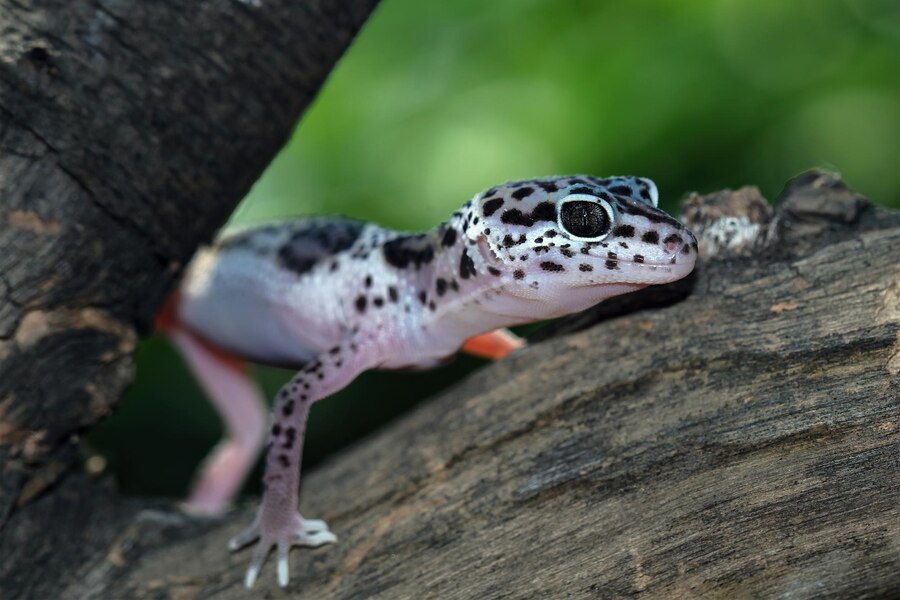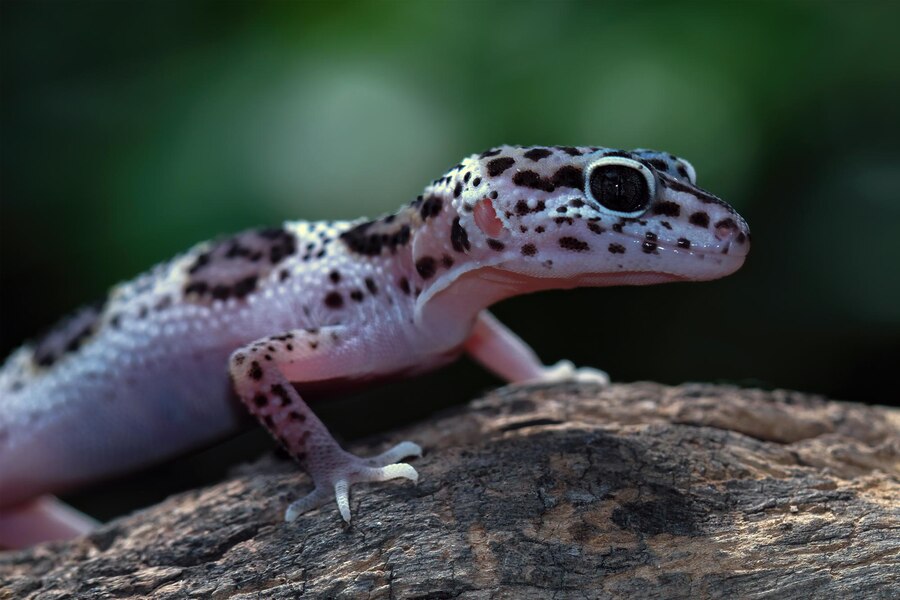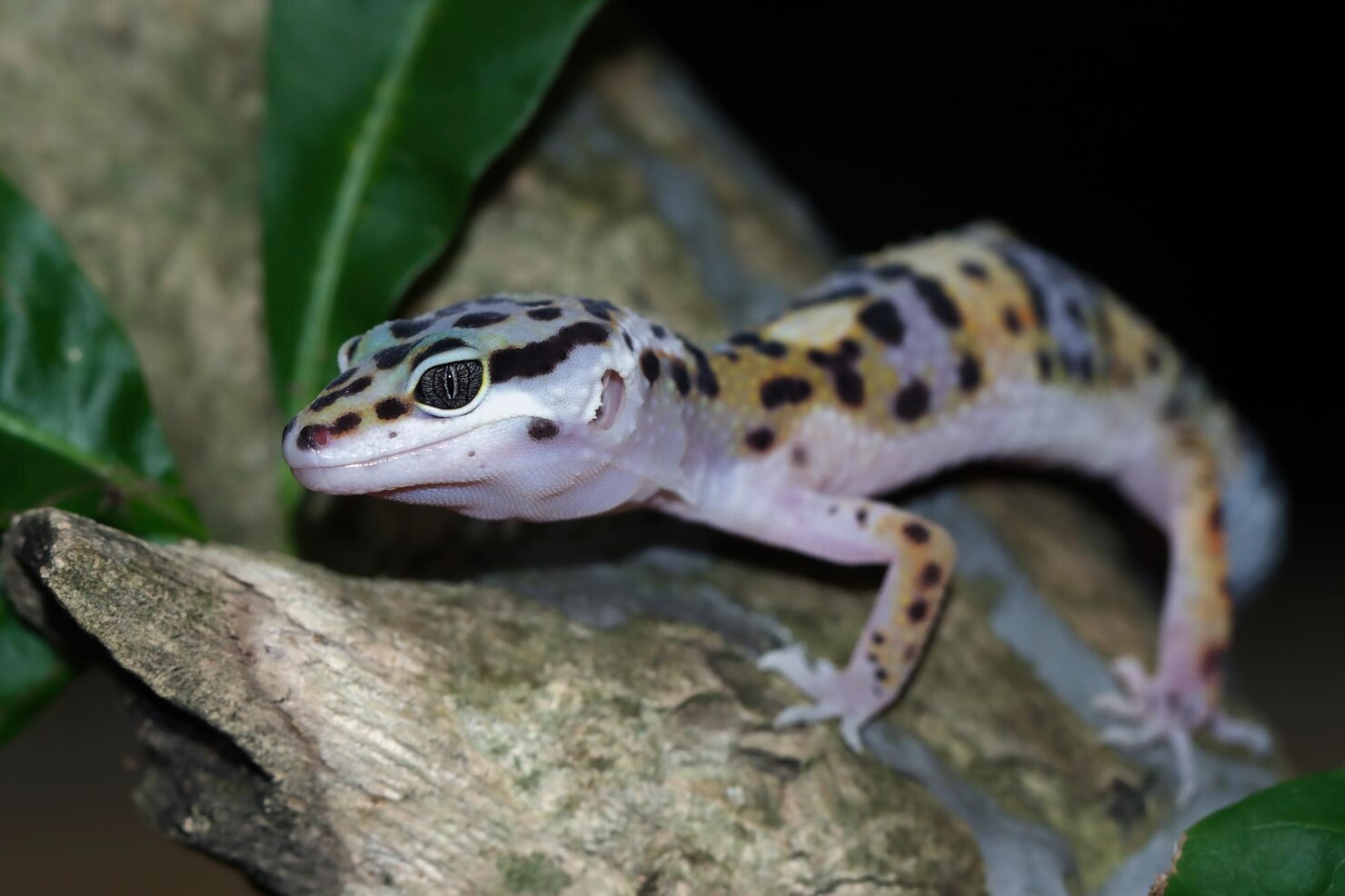Leopard geckos (Eublepharis macularius) have been popular reptile pets for decades, and it’s easy to see why. Their striking appearance, gentle disposition, and relatively low-maintenance requirements make them an excellent choice for both beginners and experienced reptile enthusiasts. However, to ensure the health and happiness of your leopard gecko, it’s essential to understand their specific needs and provide them with proper care.
In this comprehensive guide, we’ll delve into all aspects of leopard gecko care, from choosing the right enclosure to maintaining their well-being throughout their lives.
You may also want to read about how to sex leopard geckos.
Leopard Gecko Care Basics
Before we dive into the intricacies of leopard gecko care, let’s start with the basics. Leopard geckos are small lizards native to the arid regions of Pakistan, India, and Afghanistan. They are known for their distinctive appearance, with bold spots and vibrant colors, and they typically grow to be around 7 to 10 inches in length.
Here are some fundamental aspects of leopard gecko care to keep in mind:

1. Lifespan
Leopard geckos are long-lived reptiles, often living 15 to 20 years or more in captivity when properly cared for. This is a significant commitment, so be prepared for a long-term pet.
2. Behavior
Leopard geckos are crepuscular, which means they are most active during dawn and dusk. During the daytime, they usually hide in burrows or crevices. Understanding their activity patterns is essential for providing appropriate care and interaction.
3. Diet
Leopard geckos are insectivores, meaning their primary diet consists of insects. Common food items include crickets, mealworms, dubia roaches, and waxworms. It’s crucial to provide a varied and well-balanced diet.
4. Enclosure
Leopard geckos need a suitable enclosure with specific temperature and humidity requirements. A well-designed habitat is essential for their overall health and well-being.
Now that we’ve covered the basics let’s delve deeper into each aspect of leopard gecko care.
Choosing the Right Enclosure
Size Matters
Selecting the appropriate enclosure size is one of the most critical aspects of leopard gecko care. A tank that’s too small can lead to stress and health issues. Here are some general guidelines for enclosure size:
- Hatchlings: A 10-gallon tank is sufficient for a hatchling, but keep in mind that they will quickly outgrow it.
- Adults: Adult leopard geckos should be housed in a 20-gallon long tank at a minimum. Larger tanks, like 40-gallon breeders, provide more space for your gecko to roam and are ideal for multiple geckos.
Substrate Selection
Choosing the right substrate is essential for your leopard gecko’s well-being. Substrate options include:
- Paper Towels: Easy to clean and safe for hatchlings, but less aesthetically pleasing.
- Reptile Carpet: Provides a solid surface and is easy to clean, but may not be as comfortable for your gecko.
- Tile or Slate: Mimics the rocky terrain of their natural habitat and helps wear down their claws naturally.
- Eco-Friendly Loose Substrates: Coconut coir and cypress mulch are good options, but they require more maintenance to prevent impaction.
Select a substrate that suits your preferences and is appropriate for your gecko’s age and size.
Temperature and Lighting
Leopard geckos are ectothermic, meaning they rely on external heat sources to regulate their body temperature. Maintaining the proper temperature gradient in their enclosure is crucial for their health.
Basking Spot
Provide a basking spot with a temperature of around 88-92°F (31-33°C) on one side of the enclosure. This allows your gecko to thermoregulate by moving closer or further from the heat source.
Cool Side
The opposite side of the enclosure should be cooler, with temperatures ranging from 75-80°F (24-27°C). This temperature gradient allows your gecko to choose the right spot to regulate its body temperature.
Nighttime Temperature
Leopard geckos require a slight drop in temperature at night, with a range of 70-75°F (21-24°C). Using a ceramic heat emitter or under-tank heating pad can help maintain nighttime temperatures.
While leopard geckos do not require UVB lighting, providing a low-level UVB light can be beneficial for their overall health. Ensure that the UVB source is appropriate for the enclosure size and replace it as recommended by the manufacturer.

Hiding Spots and Decor
Leopard geckos are nocturnal creatures that appreciate hiding spots and a sense of security in their enclosure. Provide multiple hiding places, such as half logs, caves, or flat stones, on both the warm and cool sides of the enclosure. This allows your gecko to choose its preferred hiding spot based on temperature and security.
Adding decor elements like fake plants, rocks, and branches can enhance the aesthetics of the enclosure and provide additional enrichment for your gecko. Just be sure that all decorations are securely placed to prevent them from falling and potentially harming your pet.
Feeding and Water
Diet
Leopard geckos have simple dietary requirements, primarily consisting of insects. Offer a variety of appropriately sized insects, such as crickets, mealworms, dubia roaches, and waxworms. Dust the insects with a calcium supplement before feeding to ensure your gecko receives essential nutrients.
Avoid feeding your gecko large prey items that could potentially cause impaction. The size of the prey should not exceed the width of your gecko’s head.
Water
A shallow dish of fresh, clean water should always be available in the enclosure. However, leopard geckos rarely drink from a water dish, so it’s essential to maintain proper humidity levels to prevent dehydration.
Humidity Levels
Leopard geckos come from arid desert regions and require low humidity levels in their enclosure. Aim for a humidity level of around 20-40%. You can achieve this by providing a shallow water dish and avoiding overly damp substrates.
During shedding, you may increase humidity slightly to aid in the shedding process. Providing a humid hide (a hide with a moist substrate) can help your gecko shed its skin more easily.
Cleaning and Maintenance
Regular maintenance and cleaning are essential to keep your leopard gecko’s enclosure in optimal condition. Here’s a breakdown of what you should do:
- Remove waste: Promptly remove feces and uneaten food to maintain cleanliness.
- Substrate replacement: Replace loose substrates like coconut coir or cypress mulch as needed to prevent impaction.
- Clean decor: Periodically clean and disinfect all decor items to prevent the buildup of harmful bacteria.
- Full enclosure cleaning: Perform a thorough cleaning of the entire enclosure every few weeks. This includes removing all substrate, cleaning the tank and decor, and replacing the substrate.
By following a regular cleaning and maintenance routine, you’ll create a healthy and hygienic environment for your leopard gecko.
Handling and Interaction
Leopard geckos are generally docile and can be handled, but they may become stressed if handled too frequently or roughly. When interacting with your gecko, keep the following tips in mind:
- Start slowly: If your gecko is not used to handling, start with short sessions and gradually increase the time.
- Be gentle: Handle your gecko with care, supporting its body and avoiding sudden movements.
- Wash your hands: Before and after handling your gecko, wash your hands thoroughly to prevent the transfer of bacteria.
- Respect their signals: If your gecko tries to escape or shows signs of stress (like tail waving), put it back in its enclosure.
Not all geckos enjoy handling, so it’s essential to respect your pet’s preferences and provide a safe and stress-free environment.
Breeding Leopard Geckos
If you’re interested in breeding leopard geckos, it’s crucial to understand the additional considerations and responsibilities involved. Breeding should only be undertaken with a commitment to responsible care and finding suitable homes for the offspring. Here are some key points to consider:
- Pairing: Select a healthy male and female gecko for breeding. Ensure they are of appropriate age and weight.
- Breeding setup: Provide a separate breeding enclosure with suitable hiding spots and a lay box for the female.
- Incubation: Eggs should be carefully removed and incubated in a separate container. Monitor temperature and humidity during incubation.
- Hatchling care: Be prepared to care for hatchlings, including proper housing and feeding.
Breeding leopard geckos can be a rewarding experience, but it requires careful planning and dedication to ensure the well-being of both parents and offspring.
Common Health Issues
While leopard geckos are hardy reptiles, they can still experience health issues. Regular monitoring of your gecko’s behavior and appearance is essential for early detection of problems. Here are some common health issues to be aware of:
- Metabolic Bone Disease (MBD): Caused by a lack of calcium, vitamin D3, or improper UVB lighting. Symptoms include lethargy, tremors, and deformities.
- Respiratory Infections: Typically caused by inadequate temperature and humidity levels. Signs include wheezing, mucus around the nostrils, and open-mouth breathing.
- Impaction: Occurs when a gecko ingests substrate or large prey items. Symptoms include bloating, lethargy, and constipation.
- Shedding Issues: If humidity levels are too low during shedding, your gecko may have difficulty shedding its skin. Provide a humid hide to help with the process.
If you notice any unusual behavior or symptoms in your leopard gecko, consult a reptile veterinarian with experience in treating these animals promptly.
Conclusion of Leopard Gecko Care
Leopard geckos are fascinating and rewarding pets when provided with proper care and attention. By understanding their unique needs, from enclosure setup and temperature regulation to diet and handling, you can ensure a long and healthy life for your gecko. Remember that each leopard gecko is an individual with its preferences and behaviors, so take the time to get to know your pet and tailor their care accordingly. With dedication and responsible care, your leopard gecko can become a beloved member of your family for many years to come.

